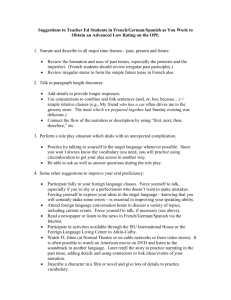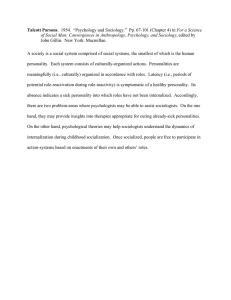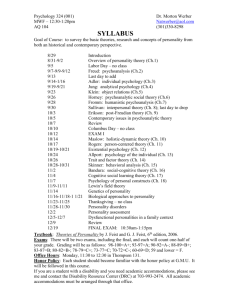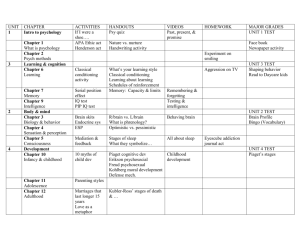The Relationship of the OPI ... Academic Achievement of Freshmen General Psychology A Thesis
advertisement
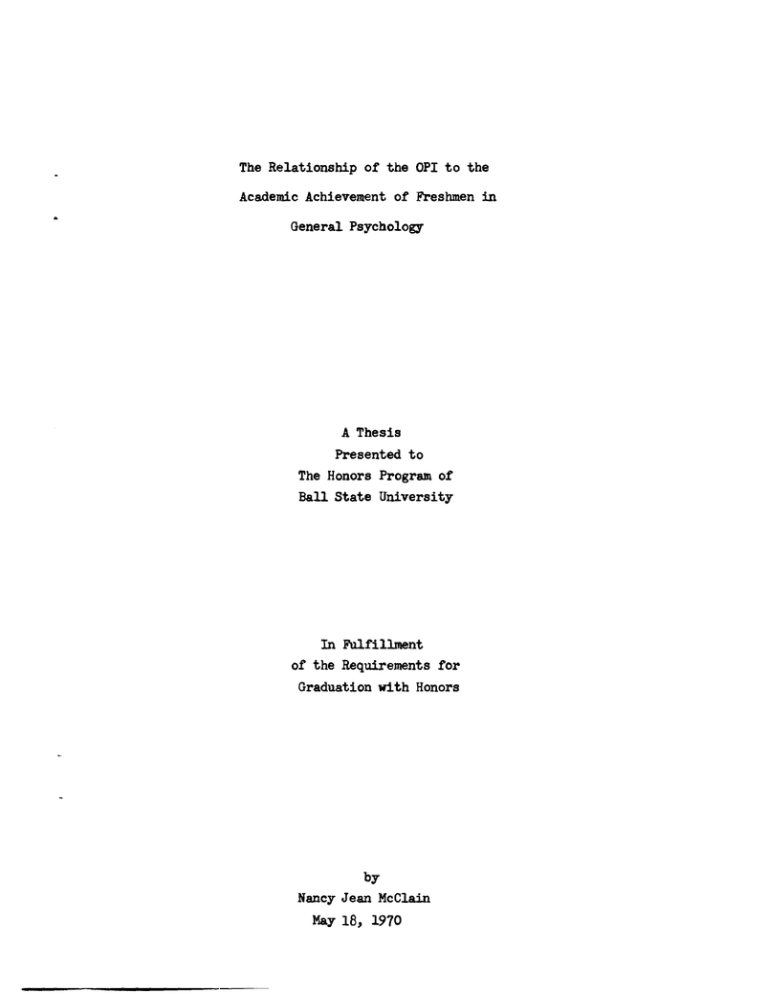
The Relationship of the OPI to the Academic Achievement of Freshmen in General Psychology A Thesis Presented to The Honors Program of Ball State University In Fulfillment of the Requirements for Graduation with Honors by Nancy Jean McClain May 18, 1970 I recommend this thesis for acceptance by Honors Program of Ball State University for graduation with honors. ii 1'·Yio (. . \ -Y6 .. ACKNCWIEDGMENTS The author wishes to acknowledge the interest in and the support and direction of the development and writing of this thesis on the part of Dr. liuth L. Myers, Professor of General-Experimental Psychology at Ball Statl! University. The author would also like to extend her appreciation to the maQY Ball State freshmen psychology students who served as experimental subjects, to the Ball State Computer Center for their assistance in the analysis of data, and to Mrs. Joan Strait for preparatjLon of the final manuscript. May 18, 1970 iii TABLE OF CONTENTS 1. ACKNOiLEDGMENTS • 2. ABSTRACT 5. RESULTS 6. DISCUSSICW 7. APPENDIXES • • 3. INTRODUCTION • 4. METHOD iii • • • • • • • • vii • 1 • • 3 • • • 6 • • • 11 • 14 • 19 • • • • • • • • • • • • • • 8. BIBLIOORAPHY • • • iv • • • • TABLES PAGE TABL1~ 1. 2. Summary of the Means and Standard Deviations MOPI Scales and Grade Point Average 7 Intercorrelations among Factors 9 3. Difference in Performance on the 15 Factors of the OPI between Shown by F values Y~les and Females as 10 v APPENDIXES APPENDIX PAGE .A. Summary of Raw Data :B Definitions of the Fourteen Scales of the OPI vi 16 ABSTRACT This study investigated the relationship of certain persona.lity factors, as measured by the OPI, to academic achievement in general psychology. It was predicted that Thinkin.g Introversion and Theoretical Orientation would correlate significantly and positively and that Practical Outlook would correlate significantly and negatively with total grade points. Intercorrelations among factors provided substantial support for HypotheSiS 1 but indicated only a trend in the direction predicted in Hypotheses 2 and 3. vii INTRODUCTION Early attempts at the prediction of academic success by means of personality (:haracteristics were not at all encouraging. A summary of these early fltudies found in Donahue, et a1. (1949, pp. 171-172) revealed a near-zero c:orrelation between scholarship and the existing adjustment inventories BLt all educational levels. The only relationship found to be at all consis,tent was a small positive correlation between introversion and grades. The major conclusion was that tlany degree of adjustment or maladjustment. as measured in personality inventories may occur with any degree of success or lack of success in school work.1t (Tyler, 1965) In spite of these discouraging early findings, psychologists have continued to search for relationships between personBLlity and academic achievement. Many of the studies in this area have used the Minnesota Multiphasic Personality Inventory (MMPI). Clark (1953) studied the relationship between the academic achievement of female college students and non-intellective factors of the MMPI and f'ound no significant profile differences toO identify achievers from non-achievers. In a study of the relationship between personality adjustment and scholastic achievement of male college students, however, Yeomans and Lundin (1957) discovered several significant relationships. Men in the upper scholastic quarters ot both the flreshman and senior classes scored significantly higher on the Mf scale, indicating greater feminine interests than that found among men in the general popUlation. Over all, the poorer students showed a greater degree of maladjustment i.e., higher scores on the Psychopathic Deviate and H~~omania scales. They were found to be more poorly motivated, irresponsible, and too active in other aff'airs to spend the necessary time and effort in their scholastic endeavors. Similar findings were 2 reported by ~rensen (1958). In a comparison of the personality traits of nonachieving students of low scholastic ability with those of achieving students of low scholastic ability, nonachieving students of high scholastic ability and ~lchieving students of high scholastic ability, he found a definite tendency for the nonachievers of low scholastic ability to deviate further from the average than any of the other groups as far as the MMPI mean scores are concerned. In a more recent study employing the Guilford-Zimmerman Temperament Survey, SuiIrr.1 (1966) found that college students described as serious or as showing rE!straint tended to achieve grades higher than had been predicted from their hi.gh school record and college aptitude scores. The inst,rument employed in the present study was the Omnibus Personality Inventory (OF'I). However, in searching through the literature the writer was unable to locate reports of many related studies using this particular measuring instrument. One study of interest making use of the OPI and four other personality tests was conducted by Goldschmidt in 1961. He hypothesized that certain personality traits would covary with a choice of major pertaining either to science or humanities. He isolated five clusters of personality characteristics which best identified each group, but in locating majors in either the area of science or humanities, psychology was found to be one of two fields (the other being anthropology) judged high on both scales. In an unpublished research report from Princeton University, Madison and Studdiford (1963) studied the relationship of the OPI to the academic achievement of freshmen. A correlation of OPI scales with first term grades revealed the correlation with the following five scales to be statistically significant: 3 TI (thinking introversion), TO (theoretical orientation), Au m~l.turity), SM (social and NA (nonauthoritarianism). (autono~), The writers felt the items of the OPI showed definite promise as a basis from which grade prediction bliLsed on personality characteristics might be developed. It was t.he purpose of the present study to investigate the relationship of the OPI tel the academic achievement of college freshmen in general psychology. The hypotheses investigated were these: 1. There will be a significant positive correlation between scores on the TI scale of the OPI and achievement in general psychology as measured by total points obtained on course examinations. 2. There will be a significant positive correlation between scores on the TO scale of the OPI and achievement in general psychology as measured by total points obtained on course examinations. 3. There will be a significant negative correlation between scores on the PO scale of the OPI and achievement in general psychology as measured by total points obtained on course examinations. METHOD Subjects A total ,of 60 freshman students enrolled in general psychology at Ball State Univers:ity served as subjects in the experiment. There were 24 males and 36 female::l ranging between the ages of 17 and 33 years. Because six were unable t.) complete the personality inventory, the data for 54 subj ects were used. PsycholOgical Instrument A standa]~ized personality inventory, the Omnibus Personality Inventory, was selected for the study. The instrument contains 385 statements belonging to one or more of 14 scales constructed to measure differences among college students in regard to attitudes, values, and interests, chiefly in the areas of normal ego-functioning and intellectual activity. The inventory focuses on three broad areas of assessment: 1. intellectual vs. non-intellectual values 2. liberal vs. conservative attitudes 3. social-emotional adjustments A definition ,of the 14 scales and a more detailed description of the instrument may be found :in Heist, P. and Williams,P.A. (1968). Personal:lty appraisal by means of inventories began during World War I with the use .:>f Woodworth f s Personal Data Sheet • Although inventories have undergone man:, changes since the time of Woodworth, their use still presents many of the same problems. use inventoriE~s Downie (1967) has pointed out that whenever we we work under certain assumptions: 1. that personalities have a certain amount of stability. 2. that over a range of similar situations the same reactions will be elicited. 3. that the more responses of a certain nature an individual makes, the more certain we can be that he possesses the trait being measured. Finding suitable criteria against which to validate personality inventories has always beE~n a maj or problem. Criteria used are usually ratings of psychologists, psychiatrists, and teachers. These ratings have low reliability, and consequently the validity ratings are low. (Downie, 1967) General findings indicate that personality inventories should be used discriminate1y, critically, and only by professional persons. (Freeman, 1962). 5 In spite of its limitations the OPI was believed to be the most adequate and promising instrument for the present study. Grades The measure of academic performance used in this study was determined by summing the total number or points obtained on four course examinations in general psychology with )20 being the maximum number of points possible. Procedure The OPI loras administered to 60 subjects enrolled in three small sections of general psychology. A uniform procedure was followed in administering the test to all three sections. The testing situation was introduced to the students by their course instructor, Dr. Ruth L. Myers, in the following manner: Each quarter we try to give students an opportunity to participate in an experiment. You have been selected to involve yourself in an experiment this quarter in the area of personality which you are now studying. This will give you a first hand acquaintance with a personality inventory. Please remember there are no right or wrong answers and that you should work as rapidly as possible. Do not stop and ponder your answers. OPI test booklets, NCS answer sheets, and soft lead (No.2) pencils were distribut.;,d to the subjects. The subjects were asked to place the following information at the top of their answer sheets: school, age, SE~X, name, year of section of psychology, and date of examination. While the subjects read iihe instructions on the cover of the booklet, the experimenter read them aloucl. Yonge, 1968). The instructions may be found in the OPI manual (Heist and Questions were then answered in a manner consistent with the printed instructions on the booklet. Subjects were given as much time as was 6 required to complete the 385 items. Due to other obligations 6 subjects were unable to complete the inventory. The 54 completed answer sheets were inspected for double-answered items and were hand-scored using the 14 keys, one for each scale, accompanying the NCS form f)f answer sheets. A profile for each subject was then filled out on the re,rerse side of each answer sheet following the directions printed on thE! profile form. RESULTS The raK data showing the performance of each subject on each of the 15 variables was amassed into table form, which may be found in Appendix A. The means and standard deviations for the total population on the OPI scales and total grade points were determined. findings is shown in Table 1. A summary of these 14 7 TABLE 1 Summary of the Means and Standard Deviations on CPI Scales and Grade Point Average OPI Scale * and G.P.A. Mean Standard Deviation Thinking Intr·oversion (TI) 22.6111 8.7293 Theoretical Qrientation (TO) 16.6296 5.7841 Estheticism (Es) 12.1481 5.1295 Complexity (Co) 15.4815 5.6625 Autonomy (Au) 25.7592 5.1566 Religious OriEmtation (RO) 12.3148 4.4548 Social Extroversion (SE) 23.2963 6.9592 Impulse Expree:sion (IE) 29.0000 10.0793 Personal Integration (PI) 30.1111 10.5333 Anxiety Level (AL) 11.3519 4.7303 Altruism (Am) 22.9630 5.5476 14.7778 6.6935 Masculinity-Femininity (MF) 25.2778 6.5896 Response Bias (RB) 11.9815 4.9385 (G.P.A.) 201.4630 36.7296 Practical Outlook Grade Point Average (PO) *See Appendix B for Detailed Description of Scales of OPl. 8 The intercorrelations among the of the 14 factors of the OPI and between each 14 factors and total grade points were calculated. The r's are reported in Table 2. 'fhe correlation between Thinking Introversion and total grade points reached the .05 level of significance, thus providing substantial confirmation of HYPothesis 1. Orientation ~~d A positive correlation between Theoretical total grade points and a negative correlation between Practical Outlook and total grade points, neither approaching the .05 level of significance, indicate only a trend in the direction predicted in Hypotheses 2 and 3. It can ~! noted in Table 2 that certain other factors of the OPI correlated significantly with grade point sununation. Personal Integration significant at the .05 A correlation with level and a correlation with Response Bias significant at the .01 level were found. F ratios were computed to measure the difference in performance on the 15 factors be1iween the male and female subjects. It can be noted in Table 3 that, as would be expected, the performance of the males and females differed significantly on the Masculinity-Femininity Scale. From these findings it may also be sadd that the male and female subjects differed significantly in their perfClI'mance on the Altruism scale, the F-ratio being 7.9639. 0\ TABLE 2 INTERCORRELATIONS AMONG FACTORS Code! TI I I Es Co Au I RO SE 1 IE 1 PI I At Am TI I --10. 79W10. 7554 10.5'78i 0.562410.0403 0.3m 10.23031 0.08971 0.23i61 0 • TO I TO I Es I Co ' Au -- 10. ~~ I 0.6iM" 0.J.1602 10.19"0 I -10.4~ O.3m 10.0466 I PO I0.4~ I GPA I 0.30nTo.i728 I 10.2346 1-0.091J3k.Ol16 0.4n! l-0.25741-0.m21 0.22311 0.24lJ 10.66141-0.3086~0.02021 O.1845I-osm 1-0.2775 I 0.0109 -- 1-0.0920 IO~1-88:i r~.21731 0.3;9;1 0.252~1-0.4m~~.1266 I 0.33~ I 0.254~ ~ SE RB 10. lhOh 10.hm I 0.027hl 0.1"10 I 0.2997I-o.1h70 I 0.OO1710.~6_81L 0.208lt ~.1326 10.2211 1-0. 2071rO. 0017 1-0.27451-0.2076 Ro MF .5675/..o:45ia 1-0.2528 fo ..548al 0.2BU 0.4390 10.1981 0.2548 -- I I 0.2052 ~.0704 1-0.1661 I I ,0.292; 1 0.245110.2410 0.44591-0.0523 1-0.3220 0.3375 1 0.0905 ~ 1-0.5111~0.19111-0.16691-0.171B IE I 1-0.07691-0.16371-0.1291 ***1 *** 0.4967 iI** ** 0.0847 0.1706 0.6565 0.2976 -- ,o.654B *** ** PI At -- Am -PO I 0.3166 -0.0320 0.2220 0.4276 0.2223 *** *** 0.2607* ,-o.173B Hl.4014 0.4860 0.1903 -0.0321 1-0.0063 MF -RB -- OPA * Significant at the .10 level .. Significant at the .05 level *** Significant at the .01 level I ..... 0.2062 1-0.1096 , 0.3786 10 TABLE 3 VARIABLE SOURCE TI Between C~roups Within Groups Total Between Oroups Within Groups Total Between Groups Within Groups Total Between G.roups Within GI'OUpS Total SUM OF SQUARES DF MEAN SQUARE F-RATIO SE Between Groups 49.5115 Within Groups 2565.6833 Total 2615.2546 IE Between Groups 150.8560 Within Groups 5335.1367 Total 5485.9922 1 52 53 1 52 53 1 52 53 1 52 53 1 52 53 1 52 53 1 52 53 1 52 53 PI Between Groups 146.3203 Wi thin Gr10ups 5845.0039 Total 5991.3242 1 52 53 146.3203 112.4039 1.3017 At Between Groups 5.4837 Wi thin Grl:)ups 1202.8269 Total 1208.3105 1 52 53 5.4831 23.1313 0.2371 Am Between Groups 220.7224 Within Grmlps 1441.1991 Total 1661.9221 220.1224 27.7154 1.9639* PO Between Groups 0.1385 Wi thin Gr()ups 2419.1895 Total 2419.3219 1 52 53 1 52 53 0.1385 46.5229 0.00)0 MF Between Groups Wi thin Grcmps Total Between Groups Within Groups Total 962.9648 1381.8660 2344.8)08 50.228) 1266.1500 1316.9180 1 52 53 1 52 5) 962.9648 26.5743 36.2)66* 50.228) 24.)606 2.0619 TO . Is Co Au RO RB 20.3663 4094.4609 4114.5242 83.7187 1722.8704 1806.5889 61.5167 1359.2313 1420.8140 3.6979 1727.1791 1731.4168 Between Groups 2.8574 Within Gr-oups Total Between Groups Within Groups Total 1433.0090 1435.8662 39.0594 1032.5852 1011.6445 * Significant at the .01 level 20.3663 78.7396 0.2587 83.1181 33.1321 2.5268 61.5767 26.1392 2.3551 3.6979 33.2265 0.1113 2.8514 27.5579 0.1037 39.0594 19.8574 1.9670 49.5715 49.3401 1.0047 150.8560 102.5988 1.4103 11 DISCUSSICti The present findings provide substantial support for the first hypothesis, predicting a significant relationship between responses on the TI scale and performance in general psychology. From the nature of the psychology class from which the subjects were obtained this finding was anticipated. The OPI Manual describes high scorers on the TI scale as persons who: ••• enjoy thought-provoking lectures, mull over ideas presented in class, examine and analyze their own motives and reactions, question teachers' statements and ideas, are interested in learning about history of human thought, and enjoy test questions in which information is in a different form than originally learned. (Heist and Yonge, 1968) Due to the nature of material presentation and examination procedures, which were very similar to those mentioned in the cited description, the author is of the opinion that students performing well in this class could very likely be characterized by the above descriptive. An important question which is raised by this finding is how much of the existing correlation is due to the nature of psychology as a subject matter and hON much is a result of the particular course under investigation. Support :is not found for the predictions expressed in HYPotheses 2 and 3. However,.9. correlation of .2084 between the TO scale and total grade points indicates a definite trend in the predicted direction. It was somewhat to the writer's surprise that this relationship was not statistically" significant, because high scoring in this scale indicates an interest in science and s.~ientific enrolled in g.~neral to the subjec~~ activities. The heterogeneity of the students psychology and the broad, general, non-laboratory approach may account somewhat for this finding. It may be that in more 12 advanced courl:5es implementing actual research and scientific activities and composed of st,udents of more restricted interests, a significant relationship between this ::5cale and performance in psychology would exist. A correl'!ltion of -.0063 offers essentially no support for the predicted relationship ~between the PO scale and total grade points. The writer has noted that th,e beginning psychology students seek very much to make the subject matter relevant and applicable. This desire for pragmatic implications may offset thle appeal of ideas and philosophical problems, and thus account for the present finding. The results reveal that two factors of the OPI, not tested by the hypotheses, also correlate significantly with performance in psychology. The author is unable to account for the significant relationship between the PI scale and tot:al grade points and feels it may be due to a chance factor. A correl,ation significant at the .01 level was shown between the RB scale and tot;!ll grade points. Al though finding is not. surprising to the author. not tested in a hypothesis, this The OPI Manual describes the high scorers on this scale as persons who: ••• enjoy thinking about problems which challenge experts, find the idea of doing research appealing, and enjoy solving problems of the type found in geometry, philosophy, or logic; they feel close to people, and do not forget ~ediately what people say to them. (Heist and Yonge, 1968) This description is very compatible with the characteristics usuallY ascribed to persons wh,:) excel in academic performance and enjoy intellectual pursuits. An anal~sis of variance revealed significant differences between sexes on two factors of the OPI, the MF scale and the Am scale. The significant difference on the MF scale is not surprising and is consistent with the results one wl:)uld expect to find on such a scale. 13 Likewise, the difference on the Am scale, with the females scoring significantly higher than the males, is not too surprising and is compatible with other psychological and sociological studies on college populations. The findi.ng with regard to the TI scale and total grade points in general psychology agr'ees with the findings of Madison and Studdiford. In a study investigating the relationship of the OPI to grades, their findings revealed a correlation significant at the .01 level between the TI scale and first term freshmen grades. However, the above cited study also found a significant relationship between the TO scale and first term grades, which i8 not compatible with the findings of the present study. The current study suggests a need for further study with the aPI in regard to its use in the prediction of academic success, in which one would investi- gate other major subject matter areas and students at various levels of academic progression from the freshman through the senior year. APPENDIX A. - • HO Ii!!: H H H H H 9 . Jti r-i9 OH 0_ 1 2 3 4 5 6 1 . 8 9 10 11 12 13 14 15 16 17 18 19 20 21 22 23 24 25 26 27 28 29 30 oS 0 ~ I> H I> !~, ~~ ~O ~-;:; r-iC> r-il&l r-ie.> r-i~ 0- e.> o E-ot 0 ........ 0- 0_ e.> 0 1 1 2 1 1 27 22 21 36 18 20 11 13 15 13 8 22 19 1 1 1 14 15 11 26, 21 15 23 11 1 1 1 2 1 1 2 2 1 1 1 1 2 1 1 2 1 2 2 1 1 1 19 35 14 23 16 18 17 34 30 17 21 35 9 23 5 6 6 10 13 23 17 101 8 14 9 101 13 10 10 13 5 28 13 28 14 10 9 l2 4 16 22 9 8 19 13 7 1 16 8 19 18 19 19 10 10 13 6 22 21 20 16 35 20 14 26 34 13 10 36 33 1L J1 15 10 20 25 9 13 24 14 20 14 11 16 15 21 9 9 13 8 18 9 21 23 25 6 14 18 25 H H I> H H H I> ~ 1><1 H 1><1 H H H 1><1 H H 1><1 ~ ~ ~ H H H >< 10<- ~ ~ ~- 90' 9- !i J:i iO' Ji JE' 9H' ~- c1! 0- 0 r-i~ 0- 0 0_ e.> r-ip., r-ifi! 0_ 0_ 0_ Mll. r-i:;a 0- 0- 0- e.> e.> e.> 0 0 0 0 G) ~~ r-iO 0- 0 18 13 10 11 8 9 25 22 21 18 22 19 37 32 27 17 32 22 32 32 3 17 3 9 12 24 13 27 24 21 29 28 6 26 10 9 209 225 205 5 15 10 204 2S 20 26 12 222 18 11 32 20 29 15 26 8 34 18 29 31 21 40 23 23 34 3 24 22 21 25 6 11 29 14 22 169 257 198 13 34 20 19 25 26 21 36 26 20 27 31 25 20 48 23 11 24 14 42 17 49 37 47 33 32 19 27 8 15 8 5 23 21 28 31 23 30 13 19 26 26 27 26 28 28 22 20 25 23 23 21 26 30 27 24 20 32 27 15 12 17 8 14 11 14 6 4 17 15 9 10 17 11 9 18 9 12 9 11 24 33 31 14 24 11 28 19 27 29 31 10 26 32 29 22 24 30 29 26 40 45 45 31 33 45 24 28 24 48 9 21 18 18 30 50 35 10 13 7 11 8 15 16 11 18 11 16 16 17 12 13 14 16 6 10 11 4 13 19 14 27 20 12 16 25 4 17 24 16 27 19 9 26 14 14 23 29 13 17 20 19 36 25 11 36 26 17 23 24 19 18 28 14 32 22 13 15 20 18 34 27 15 24 18 20 33 11 19 27 23 9 17 26 12 22 10 22 34 23 22 27 32 9 15 30 6 23 8 11 13 8 6 10 16 23 17 9 16 l2 6 8 15 6 10 10 5 9 19 12 110 229 lh2 161 175 205 143 245 210 220 254 217 119 206 264 178 228 158 205 154 225 162 15 APPENDIX A (cont.) 6 • 0 HZ -~9 .... H 0_ 0 H H H H H ~~ r-itfl 0- 0 31 32 2 33 34 35 36 1 37 2 38 2 1 1 2 ~ I> I> fit:; ,-u ~O.., J'i r-tf-l 0- 0- 0_ 0 0 0 12 35 20 16 31 24 16 25 21 11 22 17 H H H l> ~O ....~~ 0- 0- .... 0 0 I:.) H H H H H H ~ i~ M~ ....5ga Ji j~ ....fit:;"" J~ ~~ ~O 'ti3 0- I:.) 00 20 38 31 22 18 9 14 19 37 17 32 19 35 22 14 ~ ~ 27 21 22 11 29 12 20 6 22 12 H H H H H I> 13 19 20 11 J..4 H I>< I>< 0_ 00 0 to< I>ocI 00 1.J 0 !=< >< 'ci~ 0 0 00 19 13 15 11 9 19 31 21 22 18 27 31 9 21 13 9 20 8 ~- ~~ ....0 ~ 0 9 23 31 29 24 29 11 25 49 18 22 8 37 23 203 223 173 224 246 156 227 30 36 14 22 15 32 22 232 28 33 35 17 24 46 28 32 37 32 49 12 10 15 5 19 9 13 35 10 2 33 30 25 14 13 33 9 30 26 39 2 29 23 12 23 26 15 13 27 23 13 24 8 31 15 238 40 1 33 25 20 26 27 12 34 50 29 9 27 9 19 13 155 41 2 24 22 12 14 18 8 19 39 13 8 17 19 30 11 167 42 1 9 885 20 8 21 24 J4 11 20 23 27 8 275 43 2 22 19 37 14 20 41 40 17 19 13 34 15 244 2 27 20 10 18 11 23 20 33 24 49 19 27 14 31 21 190 45 2 30 24 12 20 32 25 21 32 20 8 22 5 32 14 176 46 1 30 19 21 27 31 11 18 37 23 14 29 5 19 8 238 47 2 27 13 14 8 22 2 22 15 20 3 23 22 19 16 213 48 1 9 8 9 23 11 20 12 36 4 26 18 18 13 150 49 1 33 20 19 10 29 7 30 16 50 17 35 14 22 21 260 . 50 1 14 16 13 19 23 15 20 38 15 2 13 19 16 6 242 . 51 2 18 17 9 16 13 10 28 44 21 1 17 23 J6 12 114 52 2 15 18 5 14 19 11 17 24 32 10 12 15 36 7 159 53 1 15 10 5 12 22 12 19 23 18 13 17 13 25 6 18a' 54 1 10 10 9 8 25 15 11 16 35 7 19 19 26 10 173 21 9 5 16 APPENDIX B* Definitions ot the Fourteen Scales 1. Thinking Introversion (TI) Persons scoring high on this measure are charu.cterized by a liking tor reflective thought and academic activitios. They express interests in a broad range ot ideas found in a var:Lety of areas, such as literature, art, and philosophy. Their thinking is less dominated by immediate conditions and situations, or by commonly accepted ideas, than that of thinking extrover1;s (low scorers). Most extroverts show a preference for overt action and tend to evaluate ideas on the basis of their practic~L, immediate application, or to entirely reject or avoid dealing lrith ideas and abstractions. 2. Theoreti(~al 3. Esthetic~l.sm 4. Complexi1:.y (Co) - This measure reflects an experimental and flexible orientation rather than a fixed way of viewing and organiz~lg phenomena. High scorers are tolerant ot ambiguities and uncel:-tainties; they are fond of novel situations and ideas. Most per~50ns high on this dimension prefer to deal with complexity, as opposE~d to simplicity, and very high scorers are disposed to seek out and to enjoy diversity and ambiguity. 5. Autono!y (Au) - The characteristic measured by this scale is composed of liber~wr;-non-authoritarian thinking and a need for independence. High scorers show a tendency to be independent of authority as traditionally imposed through social institutions. They oppose infringel~nts on the rights of individuals and are tolerant of viewpoin1;s other than their own, they tend to be realistic, intellect.ually and politically liberal, and much less judgmental than low scorers. Orientation (TO) - The scale measures an interest in, or orient.ation to, a more restricted range of ideas than is true of TIo High scorers indicate a preference for dealing with theoretical concerns and problems and for using the scientific method in thinking; many are also exhibiting an interest in science and in scientific activitiE~s. High scorers are generally logical, analytical, and critical in their approach to problems and situations. (Es) - High scorers endorse statements indicating diverse interests in artistic matters and activities and a high level of sensitivity and response to esthetic stimulation. The content of the statements in this scale extends beyond painting, sculpture, and music, and includes interests in literature and dramatic~, • 17 6. Religious Orientation (RO) - High scorers are skeptical of convent:Lonal religious beliefs and practices and tend to reject most of them, especially those that are orthodox or fundamentalistic in natw~e. Persons scoring around the mean are manifesting a moderat.~ view of religious beliefs and practices; low scorers are lIWlifesi~ing a strong commitment to Judaic-Christian beliefs and tend to be conservative in general and frequently rejecting of other viewpoints. 7. Social Extroversion (SE) - This measure reflects a preferred style of relating to people in a social context. High scorers display a strong interest in being with people, and they seek social nctivities and gain satisfaction from them. The social introvel-t (low scorer) tends to withdraw from social contacts and responsj.bili ties. • 8. tmPulse Expression (IE) - This scale assesses a general readiness to express impulses and to seek gratification either in conscious thought or in o1'ert action. High scorers have an active imagination, value sensual reactions and feelings; very high scorers have frequent feelinge, of rebellion and agression. 9. Personal. Integration (PI) The high scorer admits to few attitudes and behs~viors that characterize social~ alienated or emotionally disturbed persons. Low scorers often intentionally avoid others and experience feelings of hostility and aggression along with feelings of isolation, loneliness, and rejection. 10. Anxiety Level (AL) - High scorers deny that they have feelings or symptoms of anxiety, and do not admit to being nervous or worried. Low scorers describe themselves as tense and high strung. They may experience some difficulty in adjusting to their social environment, and they tend to have a poor opinion of themselves. ll. Altruism (Am) - The high scorer is an affiliative person and trusting and ethical in his relations with others. He has a strong concern tor the feelings and welfare of people he meets. Low scorers tend not to consider the feelings and welfare of others and often view people from an impersonal, distant perspective. 12. Practical Outlook (PO) - The high scorer on this measure is interested in practical, applied activities and tends to value material possessions and concrete accomplishments. The criterion most ofu~n used to evaluate ideas and things is one of immediate utility. Authoritarianism, conservatism, and non-intellectual interests are very frequent personality components of persons scoring u.bove the average. 18 13. MaSCU1iIlltY-Femininit~ 14. ResponsEI Bias (RBl - This measure, composed chiefly of items seemingly unrelated to the concept, represents an approach to assessing the students f test-taking attitude. High scorers are responding in a manner similar to a group of students who were explicitly asked to make a good impression by their responses to these items. Low scorers, on the (:ontrary, may be trying to make a bad impression or are indicatjng a low state of well-being or feelings of depression. , (MF) - This scale assesses some of the differences in attitues and interests between college men and women. High scorers (masculine) deny interests in esthetic matters, and they adrd t to few adjustment problems, feelings of anxiety or personal inadequacies. They also tend to be somewhat less socially inclined than low scorers and more interested in scientific matters.. Low scorers (feminine), besides having stronger esthetic and SOCjLal inclinations, also admit to greater sensitivity and emotioruillty • * Taken from OP! Manual, pp. 4-5. 19 BIBLIOOlUPHY Astin, Alexander W., Who Goes Where to College? Research Associates, Inc., 1965. , Chicago: Science Clark, J. H., "Grade Achievement of Female College Students in Relation to Non·-Intellective Factors: MMPI Items," Journal of Social Psycho:~ 37 (1953), pp. 275-281. Donahue, w. 'r., Coombs, C. H., and Travers, R. W. M., The Measurement of Student, Adjustment and Achievement. Ann Arbor: Universi ty of Michigan Press, 1949. Downie, N. M. Fundamentals of Measurement: Techniques and Practices. New York: Oxford University Press, 1967. Freeman, Frank S. Theory and Practice of Psychological Testing. Holt, Hinehart, and Winston, 1962. New York: Goldschmid, i-iarcel L. "Prediction of College Majors by Personality Tests," Journal of Counseling Psychology, XIV, 4 (1967), pp. 302-308. Heist, Paul and Yonge, George, Manual for the Omnibus Personality Inventorz. New York: The Psychological Corporation, 1968. Jensen, Vern H. "Influence of Personality Traits on Academic Success," Personnel Guidance Journal, 36 (1958), pp. 497-500. Madison, PetElr and Studdiford, Walter. The Relationship of the Omnibus PersoncLlit Inventor to A.cademic Achievement of Princeton Freshmen. The Cotmseling rinceton UniverSity, Ju y, 19 3 Mimeographed.) Suinn, Richard M., "Personality and Grades of College Students of Different Class Ranks," Educational and Psychological Measurement, XXVI, 4 (1966), pp. 1053-1054. Sutherland, Eobert L., et ale (eds.) Personality Factors on the College Campus. Austin: Hogg Foundation for Mental Health, 1962. Vermont: Brandon, Traxler, Arthur E., The Use of Tests and Rating Devices in the ArraiSal of Personality. New York: Educational Records Bureau, 193 • " Tyler, Leona K. The Psychology of Human Differences. Publishing Company, 1965. New York: Meredith Yeomans, William N. and Lundin, Robert W., "The Relationship Between Personality Adjustment and Scholastic Achievement in Male College Students," Journal of General Psychology, 57 (1957) pp. 213-218.



